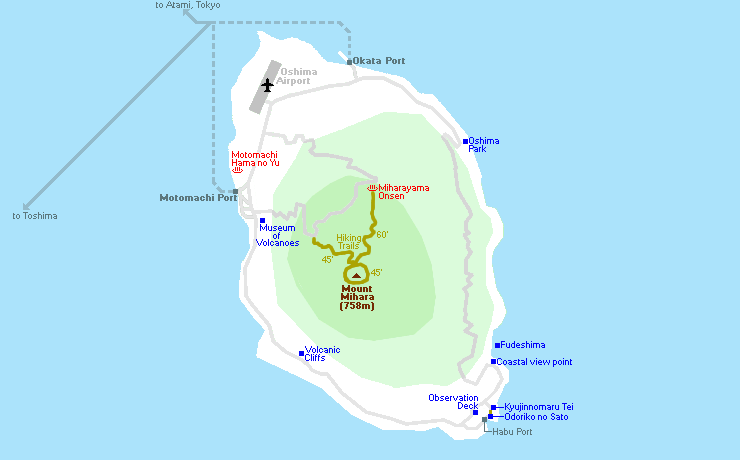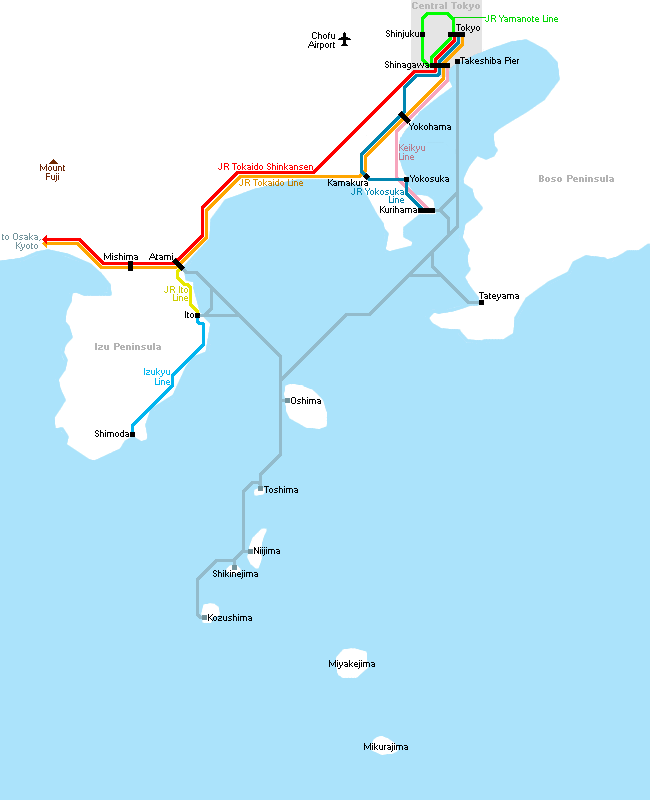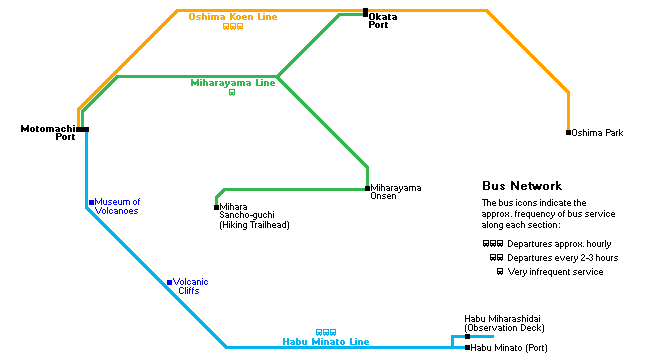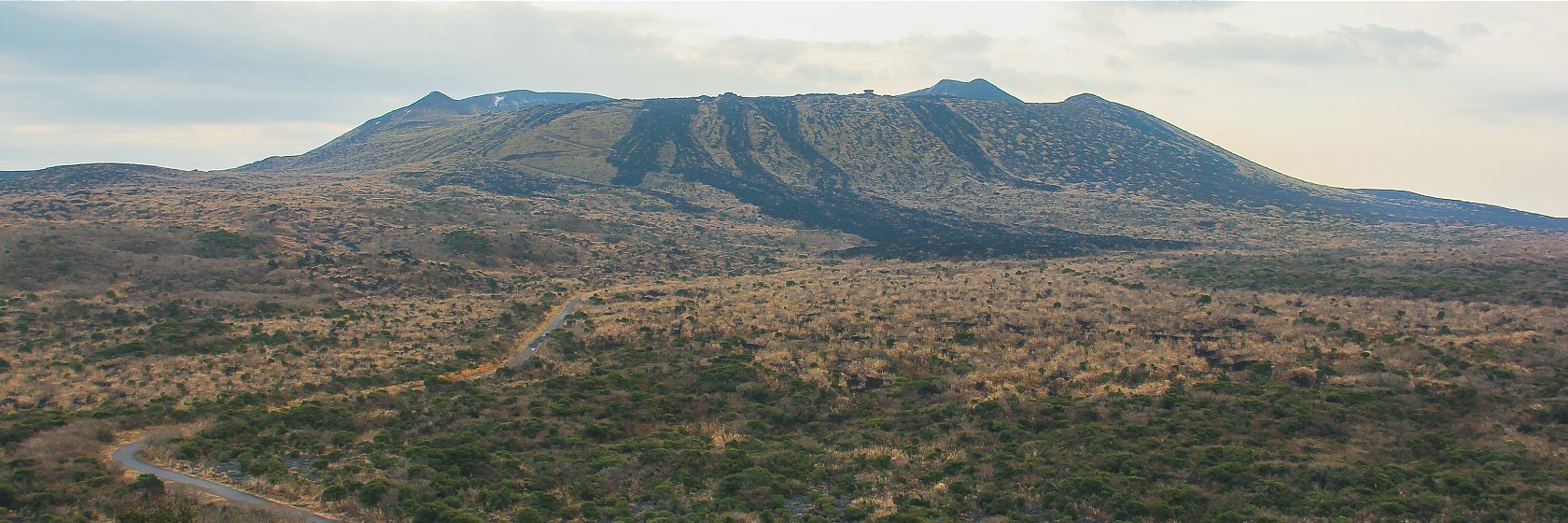Izu Oshima (伊豆大島, Izu Ōshima) is the largest of the Izu Islands, a group of volcanic islands under the administration of Tokyo, close in proximity to the Izu Peninsula. Oshima is located about 100 kilometers south of the capital. The island takes about one hour to circle by car and is a popular tourist destination, especially for those in Tokyo seeking a short getaway.
At the heart of Izu Oshima is the 758 meter tall Mount Mihara, an active volcano which is the source of several interesting sites and various hot springs on the island. Beaches at the island's northern and western coasts are the venue for snorkeling, sunbathing and other beach activities during summer. Oshima is also known for its camellia flowers, which can be spotted almost everywhere from around January through March.

Mount Mihara is a volcano that frequently erupts, most recently in 1990. A major eruption in 1986 saw spectacular explosions, with lava overflowing from the summit caldera onto the northwestern slopes of the mountain, resulting in an evacuation of more than ten thousand inhabitants. Today, visitors can hike up the mountain and see the caldera up close, as well as learn more about volcanoes at the Museum of Volcanoes.
The thermal activity occurring underground Oshima produces a few hot springs. The thermal waters can be enjoyed at some public baths and ryokan the latter of which open their baths also to non-staying guests during the day for typically 500-1000 yen. Below are two of the baths accessible to daytime visitors:
Perhaps nowhere else in Japan can so many Camellia (Tsubaki) plants of different varieties be found at a single location than on Oshima. The plants' flowering periods differ by variety, but many are in bloom from January through March across the island, especially in February. A festival is held from around late January to late March. The best place to view camellia is Oshima Park which showcases thousands of camellia plants of around 450 varieties. Oil extracts from tsubaki seeds are used in popular hair and skin products that have become famous nationwide under the Oshima Tsubaki brand.

At the southern end of the island lies Habu Port (Habu Minato), surrounding an inlet which used to be a crater lake until a tsunami connected it to the sea in 1703. The fishing port has a laid back atmosphere which has inspired the creation of many artistic works in the past such as the song "Habu no Minato". Some sites of interest in the vicinity of the port are:
Getting there and around
How to get to Izu Oshima

By high speed ferry
Tokai Kisen runs high speed ferries (jetfoils) between Izu Oshima and Tokyo's Takeshiba Ferry Terminal (about two hours, around 8000-8500 yen one way, two departures per day, more during peak seasons), with some ferries stopping at Kurihama or Tateyama (seasonally) en route. Takeshiba Ferry Terminal is located just beside Takeshiba Station on the Yurikamome Line. There are also high speed ferry connections between Oshima and Atami (one hour, about 5500 yen one way, one departure per day, more during peak seasons), with some ferries stopping at Ito en route. Online reservations can be made though Direct Ferries.
By regular ferry
Tokai Kisen also runs regular car ferries almost daily between Izu Oshima and Tokyo's Takeshiba Ferry Terminal. The one way trip takes about 6-8 hours and costs around 5000-5500 yen in the cheapest class. The ferry in direction of Oshima runs overnight, while the return journey is during the daytime. Online reservations can be made though Direct Ferries.
By air from Chofu Airport
New Central Airservice operates 2-3 daily flights in each direction between Tokyo's Chofu Airport and Oshima Airport. The one way trip takes approximately 25 minutes and costs 12,000 yen. To get to Chofu Airport, take the Keio Railway from Shinjuku to Chofu Station (15 minutes, 250 yen one way) and transfer to a bus (15 minutes, 220 yen) or taxi (15 minutes, about 2000 yen) to the airport.
How to get around Izu Oshima
Izu Oshima's largest town is Motomachi around Motomachi Port on the island's west coast. Smaller towns are also located around Okata Port in the north and Habu Port in the south.
Izu Oshima has a unique system whereby all ferries use either Motomachi Port or Okata Port depending on weather and sea conditions. The port to be used is decided on a daily basis and announced on the ferry operator's website (Japanese only). You can also check with staff at the hotel or ryokan you are staying at. Rental car pickups and bus services will be adjusted according to the selected port of the day.
Because public transportation is not too convenient on Izu Oshima, rental cars are a convenient way to tour the island. Rental outlets are found at Motomachi Port, but with prior arrangement, cars can also be picked up and returned at Okata Port or the airport. Alternatively, rental bicycles are available near Motomachi Port for typically 600 yen per hour or 1500 yen per day. With a circumference of about 50 kilometers and a mountain at its center, the island is not easily explored by bicycle entirely, though.
Oshima offers a bus network with relatively frequent service along the coastal roads, except the eastern coast which is not served. Bus service into the island's interior is infrequent. Bus fares range from 130 to 940 yen depending on distance traveled.

Questions? Ask in our forum.













